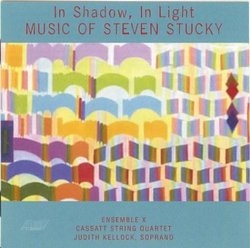Chamber Music by Steven Stucky
J Scott Morrison | Middlebury VT, USA | 06/19/2004
(4 out of 5 stars)
"Steven Stucky, a native of Kansas (yay!), has long been professor of composition at Cornell and his music has been performed by many different artists and groups. This compilation of chamber music illustrates his ability to convey, through a sort of musical impressionism, visual images, feelings, texts, ideas. His technique makes use of much of the usual twentieth-century composer's arsenal, including Bartókian counterpoint, twelve-tone rows (not manipulated serially), allusive orchestration, innovative forms and striking contrasts. The title of 'Nell'ombra, nella luce' ('In Shadow, In Light'), played brilliantly here by the Cassatt String Quartet, illustrates one of Stucky's favorite formal gestures, the contrast of light and dark music, the former often by sparse and skittery upper-register material, the latter by slower, denser low-register passages. 'In Shadow, In Light' is a one-movement string quartet in all but name. Lasting 16+ minutes is traverses four main sections that serve as opening movement, adagio, scherzo with trio, and finale. The rest of this disc is performed by Ensemble X, a chamber group co-founded by Stucky in 1997. In the last piece, 'Sappho Fragments,' they are joined by soprano Judith Kellock. Many recent composers,including Sandor Veress, Tan Dun and Gunther Schuller, to name a few, have been inspired by the paintings of Paul Klee. Stucky's 'Ad Parnassum' was inspired by Klee's painting of that name. Klee had taken his title from J. J. Fux's monumental musical treatise, 'Gradus ad parnassum,' ('Onward and Upward to Parnassus'); Debussy had used the same title for the opening section of his 'Children's Corner Suite' in which he satirized five-finger exercises that were and are the bane of every beginning piano student. Stucky resists that too-easy structural procedure and, rather, attempts to put into sound his response to Klee's painting. It might have been helpful to have had the painting reproduced on the cover of the booklet, but that would have meant that the striking painting on the cover, 'Concerto for Orchestra by Steven Stucky,' by Nancy Mooslin, would have had to be scrapped. It's just as well. Klee's masterpiece is easily available on the Internet if any are interested in looking at it while listening to this work. For those who have not seen it, it is a parti-colored mosaic-like quasi-architectural picture which Klee himself labeled a 'polyphonic composition.' Stucky successfully illustrated musically the conflict of areas of tension and relaxation inherent in Klee's painting.'Boston Fancies,' a 15-minute set of seven miniatures played without pause, consists of quick-tempo ritornelli alternating with slower 'fancies.' 'Ritornello' is a misnomer, actually, since none of the material is 'returned' literally in each succeeding ritornello as it would have been in the Baroque era; rather their basic materials are re-composed. Instrumentation includes flute (doubling on alto flute), clarinet (doubling with bass clarinet), percussion (various instruments), piano, violin, viola and cello. 'Partita-Pastorale, after J.S.B.' is a seven-minute recomposition (and re-orchestration) of Bach's B flat harpsichord partita, but with a dreamlike character that allows for reminiscences of numerous other Bach pieces (e.g. two of the Goldberg Variations - Nos. 6 and the 'Black Pearl,' No. 25 as well as bits of a French suite and the A minor prelude from WTC II). I adored it! But then I'm a goner for this kind of thing [e.g. see my Amazon reviews of Uri Caine's recomposition of the entire Goldbergs and Robin Holloway's two-piano set of pieces based on each of them]. Finally, there is the 12-minute set of vocal settings of all of Sappho's extant poetry, brief as they are. They are sung expertly, dramatically, effectively by Judith Kellock, accompanied by Ensemble X under Stucky's direction. If you like modestly advanced neo-classic American chamber music (although that characterization falls short of any signficant explication of Stucky's style), this one's a keeper.TT=61:40Scott Morrison"


 Track Listings (5) - Disc #1
Track Listings (5) - Disc #1